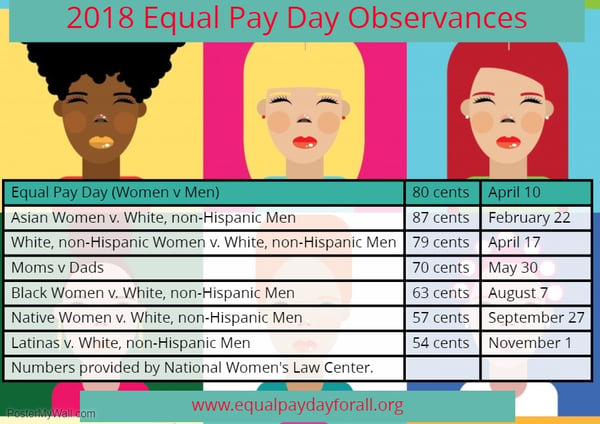Equal Pay Day in the United States is 10 April this year, but what does this actual mean? On the surface it means that the average woman in the United States needs to work 15 months to earn the same amount that their male peers earn in 12. But this does not paint the full picture.

The April date of Equal Pay Day represents the average women in the United States have to work to make the same as their male counterparts - the key word is average. African American women have to work until August, Native American women need to work until September, and Latinas have to work until November. Yes, I wrote that correctly, November. There are many factors that contribute these different numbers, but the big ones are occupational choices, access to education, and of course, Gender Dynamics and the ever looming Motherhood Penalty.
For more information on how the American Association of University Women (AAUW) marks these days, check out the following links:
22 February 2018
Asian American Women’s Equal Pay Day30 May 2018
Mothers’ Equal Pay Day7 August 2018
Black Women’s Equal Pay Day27 September 2018
Native American Women’s Equal Pay Day1 November 2018
Latinas’ Equal Pay Day
These inequalities add up and have a devastating impact on lifetime earnings. According to the National Women's Law Center:
Based on [the 2015] wage gap, women would lose $418,800 over the course of a 40-year career. This “lifetime wage gap” exists across the [US]: in every state, women’s career losses based on today’s wage gap would amount to nearly one-quarter of a million dollars or more—and in nine states women’s career losses would amount to more than half a million dollars.
But again, this $418,800 number is the average for all women in the United States. When you factor of race this number doubles to $840,040 for Black Women, $934,240 for Native American women, and over $1 million for Latinas.
It can't be up to women alone to close the wage gap that is fundamentally created by managers who make inequitable salary decisions. Companies must conduct wage equity audits, make appropriate adjustments and monitor managers' wage decisions to ensure equal pay for equal work.
Are you serious about closing the leadership gender gap for all women in your organization? For more information on how to close it, check out these additional blog posts and contact us to help develop a game plan for your company to close the leadership gender gap!







